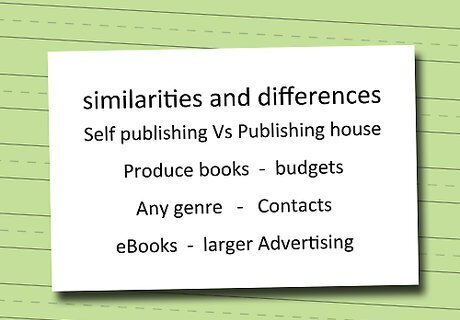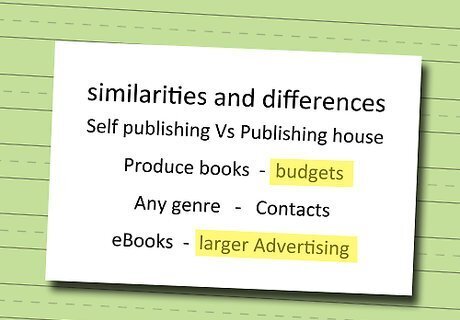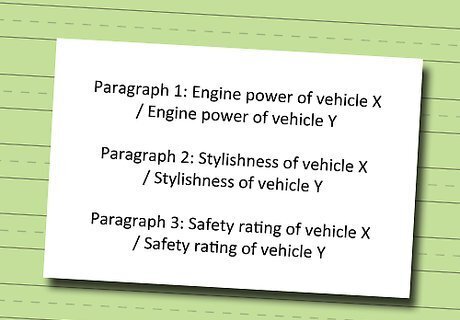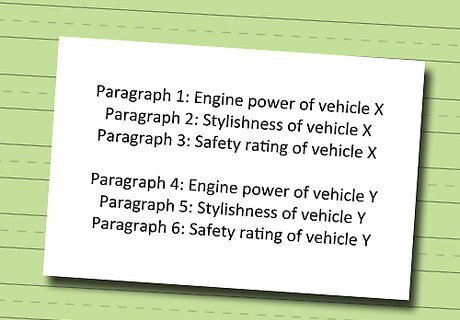
views
How to Develop the Essay Content

Analyze the question or essay prompt carefully. You may have a great idea for a paper in your head, but if it doesn't perfectly match the prompt, you may not create the product your instructor has asked for. Look over the prompt (and rubric, if you have one) carefully and underline key phrases. Keep a list of these things by you as you work. Many comparative essay assignments will signal their purpose by using words such as "compare," "contrast," "similarities," and "differences" in the language of the prompt. Also see whether there are any limits placed on your topic.

Understand the type of comparison essay you are being asked to write. While some essays may be simple compare/contrast essays, others may ask you to begin with that framework and then develop an evaluation or argument based on your comparisons. For these essays, simply pointing out that things are similar or different will not be sufficient. The assignment will generally ask guiding questions if you are expected to incorporate comparison as part of a larger assignment. For example: "Choose a particular idea or theme, such as love, beauty, death, or time, and consider how two different Renaissance poets approach this idea." This sentence asks you to compare two poets, but it also asks how the poets approach the point of comparison. In other words, you will need to make an evaluative or analytical argument about those approaches. If you're unclear on what the essay prompt is asking you to do, talk with your instructor. It's much better to clarify questions up front than discover you've written the entire essay incorrectly.

List similarities and differences between the items you are comparing. Showing the similarities between the two subjects is the essence of a comparison paper, but you also need to recognize their differences. Making an effective comparison requires that you examine the differences between the subjects, as well. By examining the contrast between your subjects, you can provide valuable insights into how they relate to each other. The best place to start is to write a list of things that the items you are comparing have in common as well as differences between them.

Evaluate your list to find your argument. It is likely that you will not be able to write about everything on your list. Read through the list and try to identify a theme or patterns among items that are listed. This can help you decide on the basis of your comparison. After you work through the list, you should have the building blocks of your argument and thesis. You may want to develop a system such as highlighting different types of similarities in different colors, or use different colours if you are using an electronic device. For example, if you are comparing two novels, you may want to highlight similarities in characters in pink, settings in blue, and themes or messages in green.

Establish the basis for your comparison. This provides the context for your comparison: how will you examine these two things? Among other things, the basis could be a theoretical approach, such as feminism or multiculturalism; a question or problem that you wish to discover an answer for; or a historical theme, such as colonialism or emancipation.The comparison needs to have a specific thesis or overarching idea that determines the reason why you are comparing the two (or more) objects. The basis for your comparison may be assigned to you. Be sure to check your assignment or prompt. A basis for comparison may have to do with a theme, characteristics, or details about two different things. A basis for comparison may also be known as the “grounds” for comparison or a frame of reference. Keep in mind that comparing 2 things that are too similar makes it hard to write an effective paper. The goal of a comparison paper is to draw interesting parallels and help the reader realize something interesting about our world. This means your subjects must be different enough to make your argument interesting.

Research your subjects of comparison. Although you want to have a thorough understanding of both things being compared, it’s important not to provide more details than the assignment can handle. Compare a few aspects of each topic instead of trying to cover both topics comprehensively. Research may not be required or appropriate for your particular assignment. If your comparative essay is not meant to include research, you should avoid including it. A comparative essay about historical events, social issues, or science-related topics are more likely to require research, while a comparison of two works of literature are less likely to require research. Be sure to cite any research data properly according to the discipline in which you are writing (eg, MLA, APA, or Chicago format).

Develop a thesis statement. Every essay should be controlled by a clear, concise thesis statement. Even if your basis for comparison was assigned to you, you need to express in a single sentence why you are comparing the two items. The comparison should reveal something about the nature of the items or their relationship to each other, and your thesis statement should express that argument. Your thesis needs to make a claim about your subjects that you will then defend in your essay. It's good for this claim to be a bit controversial or up for interpretation, as this allows you to build a good argument.
How to Organize the Content

Outline your comparison. Before you start writing, it is best to plan out your organization strategy. A unique feature of a comparative essay is that you have several different organizational strategies to choose from. Use a traditional outline form if you would like to, but even a simple list of bulleted points in the order that you plan to present them would help. You can also write down your main points on sticky notes (or type them, print them, and then cut them out) so that you can arrange and rearrange them before deciding on a final order.

Use a mixed paragraphs method. Address both halves of the comparison in each paragraph. This means that the first paragraph will compare the first aspect of each subject, the second will compare the second, and so on, making sure to always address the subjects in the same order. The advantages of this structure are that it continually keeps the comparison in the mind of the reader and forces you, the writer, to pay equal attention to each side of the argument. This method is especially recommended for lengthy essays or complicated subjects where both the writer and reader can easily become lost. For Example: Paragraph 1: Engine power of vehicle X / Engine power of vehicle Y Paragraph 2: Stylishness of vehicle X / Stylishness of vehicle Y Paragraph 3: Safety rating of vehicle X / Safety rating of vehicle Y

Alternate the subjects in each paragraph. Devote every other paragraph to one of the subjects. This means that the first paragraph will compare one aspect of a subject and the second, the same aspect of the other subject; the third paragraph will compare a second aspect of a subject and the fourth, the same aspect of the second subject – and so on, making sure to always address each subject in the same order. The advantages of this structure are that it allows you to discuss points in greater detail and makes it less jarring to tackle two topics that radically different. This method is especially recommended for essays where some depth and detail are required. For example:Paragraph 1: Engine power of vehicle XParagraph 2: Engine power of vehicle YParagraph 3: Stylishness of vehicle XParagraph 4: Stylishness of vehicle YParagraph 5: Safety rating of vehicle XParagraph 6: Safety rating of vehicle Y

Cover one subject at a time thoroughly. This means that the first set of body paragraphs is devoted to addressing every aspect of the first subject and the second set, to addressing every aspect of the second subject, making sure to address each aspect in the same order. This method is by far the most dangerous, as your comparison can become both one-sided and difficult for the reader to follow. This method is only recommended for short essays with simplistic subjects that the reader can easily remember as (s)he goes along. For example:Paragraph 1: Engine power of vehicle XParagraph 2: Stylishness of vehicle XParagraph 3: Safety rating of vehicle XParagraph 4: Engine power of vehicle YParagraph 5: Stylishness of vehicle YParagraph 6: Safety rating of vehicle Y
How to Write the Essay

Write your essay out of order. In many cases, writing your essay from start to finish is harder than writing it out of order. Also, you'll likely find yourself revising the early parts of your essay once you complete the body of the paper. Instead, you can opt to write your sections out of order. However, you always need to write your thesis statement before you can get started. Body paragraphs first. Work through all that information you've been compiling and see what kind of story it tells you. Only when you've worked with your data will you know what the larger point of the paper is. Conclusion second. Now that you've done all the heavy lifting, the point of your essay should be fresh in your mind. Strike while the iron’s hot. Start your conclusion with a restatement of your thesis. Intro last. Open your introduction with a "hook" to grab the reader's attention. Since you've already written your essay, choose a hook that reflects what you will talk about, whether it's a quote, statistic, factoid, rhetorical question, or anecdote. Then, write 1-2 sentences about your topic, narrowing down to your thesis statement, which completes your introduction.

Write the body paragraphs. The first sentence of a body paragraph (often called the topic sentence) prepares the reader for what you’ll be covering in that paragraph, the middle of the paragraph presents the information you've gathered, and the last sentence draws a low-level conclusion based on that information. Be careful not to overstep the bounds of the paragraph by making a much larger point about your two topics; that’s the job of the conclusion paragraph. Organize your paragraphs using one of the approaches listed in the "Organizing the Content" part below. Once you have defined your points of comparison, choose the structure for the body paragraphs (where your comparisons go) that makes the most sense for your data. To work out all the organizational kinks, it’s recommended that you write an outline as a placeholder. Be very careful not to address different aspects of each subject. Comparing the color of one thing to the size of another does nothing to help the reader understand how they stack up.

Write the conclusion. When the essay’s done, the reader should feel like (s)he learned something and know that the essay is done, not be looking around for missing pages. The conclusion should open by giving a brief, general summary of the points you covered in the body paragraphs, then draw a larger conclusion about your two subjects. (Be careful to base your conclusion in the data and not your personal preferences, especially if your essay prompt has instructed you to keep a neutral tone.) The last sentence of the essay should leave the reader feeling that all the different threads of the essay have been drawn together in a cohesive way. Be aware that your various comparisons won’t necessarily lend themselves to an obvious conclusion, especially because people value things differently. If necessary, make the parameters of your argument more specific. (Ex. “Though X is more stylish and powerful, Y’s top safety ratings make it a more appropriate family vehicle.”) When you have two radically different topics, it sometimes helps to point out one similarity they have before concluding. (i.e. "Although X and Y don't seem to have anything in common, in actuality, they both ....”)

Write the introduction. Start with a general point that establishes the similarity between the two subjects, then move to the specific focus of the essay. At the end of the introduction, write a thesis statement that first announces which aspects of each subject you plan to compare and then states what conclusion you've drawn from them.

Revise your writing. If time is not an issue, the best way to revise your work is to leave it for a day. Go out, have something to eat or drink, have fun - forget about the paragraph/essay until tomorrow. Once you settle down to revise, remember that the two most important things to do are to find problems and to fix them. These should be done separately (i.e., go through and find all the problems you can without correcting them, then tackle them during a second run-through). Although it is tempting to do them at the same time, it is smarter to do them one by one; this ensures you have checked everything and, ultimately, makes the job quicker and more efficient. Even the best writers know editing is important to produce a good piece. Your essay will not be your best effort unless you revise it. If possible, find a friend to look over the essay, as he or she may find problems that you missed. It sometimes helps to increase or decrease the font size while editing to change the visual layout of the paper. Looking at the same thing for too long makes your brain fill in what it expects instead of what it sees, leaving you more likely to overlook errors.

















Comments
0 comment